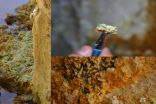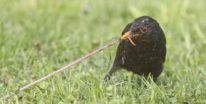Cannabis use and the increased risk of psychosis: The debate continues
2013-01-11
(Press-News.org) The scientific community have long debated the causal relationship between cannabis use and the risk factor for psychotic illnesses such as schizophrenia. Both sides of this controversial subject are put forward in two articles published today in F1000 Medicine Reports. To give rise to the debate, the authors of each article were given the opportunity to read the opposing side's article drafts and consider their arguments when structuring their own article.
In his article "Cannabis and psychosis: what causes what?" David Castle of the University of Melbourne argues for a causal link between cannabis use and an increased risk of psychotic symptoms. He does, however, concede that very few cases of schizophrenia would be prevented by a global abolition of cannabis, an argument put forward by Suzanne Gage, Stan Zammit and Matt Hickman of the Universities of Bristol and Cardiff in their article entitled "Stronger evidence is needed before accepting that cannabis plays an important role in the aetiology of schizophrenia in the population."
Gage et al argue that whilst acute psychotic experiences can be linked to cannabis use, the nature of the connection to schizophrenia inevitably remains much less certain. They argue that more robust evidence is required to determine whether preventing cannabis use will have any substantial impact on preventing psychotic disorders in the population, or within specific high-risk subgroups.
In their conclusions, both sides agree that cannabis is a public health concern and that the public should be made fully aware of the risks associated with using the drug. Castle states that this particularly applies to those who have a family history of schizophrenia or who have experienced psychosis-like symptoms, as they may be at greater risk.
###
To find out more about Faculty of 1000, please contact Eleanor Howell. For more information, visit http://f1000.com. END
ELSE PRESS RELEASES FROM THIS DATE:
2013-01-11
Misguided killer T cells may be the missing link in sustained tissue damage in the brains and spines of people with multiple sclerosis, findings from the University of Washington reveal. Cytoxic T cells, also known as CD8+ T cells, are white blood cells that normally are in the body's arsenal to fight disease.
Multiple sclerosis is characterized by inflamed lesions that damage the insulation surrounding nerve fibers and destroy the axons, electrical impulse conductors that look like long, branching projections. Affected nerves fail to transmit signals effectively.
Intriguingly, ...
2013-01-11
An international team of physicists has calculated the efficiency of a reaction involving an incoming electron kicking out an electron from the metal beryllium (Be) or its hydrogen compound molecules, in an article about to be published in EPJ D. The efficiency, which partly depends on the electron's incoming speed, is encapsulated in a quantity referred to as electron-impact ionisation cross sections (EICS). Electron-molecule interactions matter because they occur in a broad range of applications from the simplest like fluorescent lamps to the most complex, for example, ...
2013-01-11
The extent to which three-dimensional structure is required for protein recognition and function is an area of vigorous debate with clear implications for protein engineering. Two differing viewpoints have been put forward in two articles published in F1000 Biology Reports today.
In structuring their arguments, the authors were encouraged to consider the opposing viewpoint, examine the points put forward and critique them in their own articles. This novel collaborative approach has given rise to a considered exchange of ideas and may consequently stimulate further research ...
2013-01-11
Researchers at the Centre of Astrobiology have identified microorganisms that live inside salt deposits in the acidic and ferrous environment of the Tinto River in Huelva, Spain. The extreme conditions of these microniches appear to be similar to those of the salt deposits on Mars and Jupiter's moon, Europa. This possibility should be borne in mind on missions operating in these places, such as Curiosity.
The high doses of radiation, lack of moisture and extreme temperature and pressure on the surface of Mars make the development of life difficult. Within this hostile ...
2013-01-11
An enzyme treatment which could neutralise the effects of lethal chemicals responsible for the deaths of hundreds of thousands of people across the world has been developed by experts at the University of Sheffield.
Organophosphorus agents (OP) are used as pesticides in developing countries and acute poisoning is common because of insufficient control, poor storage, ready availability, and inadequate education amongst farmers.
It is estimated about 200,000 people die each year across the world from OP poisoning, through occupational exposure, unintentional use and misuse, ...
2013-01-11
Athens, Ga. – Even when at rest, the human body is a flurry of activity. Like a microscopic metropolis locked in a state of perpetual rush hour traffic, the trillions of cells that make us who we are work feverishly policing the streets, making repairs, building new structures and delivering important cargo throughout the bustling organic society.
For everything to work properly there must be something to organize and direct the various workers. Enter protein kinases. Like specialized traffic signals, this huge class of proteins is critical for many aspects of cell communication, ...
2013-01-11
Researchers used induced pluripotent stem cells (iPSCs) derived from a young patient with Long QT syndrome (LQTS), a congenital heart disorder, to determine a course of treatment that helped manage the patient's life-threatening arrhythmias. The results, which appear in The Journal of General Physiology, could lead to improved treatments for LQTS and other channelopathies, diseases caused by disturbed ion channel function.
iPSCs—adult cells that have been genetically reprogrammed to function like embryonic stem cells—provide a valuable tool for studying diseases and ...
2013-01-11
This press release is available in German.
Animals have developed a variety of strategies for dealing with increasing noise pollution in their habitats. It is known, for example, that many urban birds sing at a high pitch to differentiate their song from the low-frequency sound of road traffic. However, as scientists from the Max Planck Institute for Ornithology discovered, this is just a useful side effect. The real reason for this behaviour is that songs at a higher pitch are also automatically louder. The birds can make themselves heard far better in city noise ...
2013-01-11
This press release is available in Spanish.
By examining what lady beetles eat, U.S. Department of Agriculture (USDA) scientists are learning more about the movement of these beneficial insects in farm fields—and whether they'll actively feed on crop pests.
Agricultural Research Service (ARS) entomologist Jonathan Lundgren at the North Central Agricultural Research Laboratory in Brookings, S.D., and former ARS entomologist Michael Seagraves were part of a team of ARS and university scientists that examined how a lady beetle's diet alters its feeding patterns and ...
2013-01-11
Peering deep into the dim edges of a distorted pinwheel galaxy in the constellation Ursa Major (the Great Bear), astronomers at Case Western Reserve University and their colleagues have discovered a faint dwarf galaxy and another possible young dwarf caught before it had a chance to form any stars.
Within the faint trails of intergalactic traffic, the researchers also found more evidence pointing to two already known dwarf galaxies as probable forces that pulled the pinwheel-shaped disk galaxy known as M101 out of shape.
M101 is the dominant member in a group of 15 ...
LAST 30 PRESS RELEASES:
[Press-News.org] Cannabis use and the increased risk of psychosis: The debate continues



